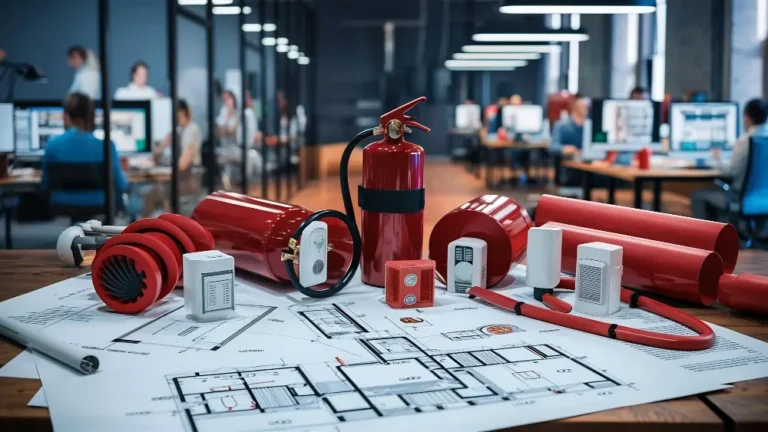Integrating Smart Sensors for Real-Time Fire Safety Management
In today’s rapidly advancing world, fire safety is no longer limited to traditional alarms and manual fire extinguishing systems. The emergence of smart sensors and real-time monitoring technologies has transformed how we detect, respond to, and prevent fire hazards. In India, where infrastructure growth and urbanization are at an all-time high, integrating smart sensors for real-time fire safety management has become not just a technological upgrade—but a necessity.
This article explores how smart sensors are revolutionizing fire safety, their benefits, applications, and how they align with India’s growing emphasis on intelligent infrastructure.
The Evolution of Fire Safety: From Reactive to Proactive
For decades, fire safety systems in India have largely been reactive—alarms ringing after smoke or heat reaches dangerous levels. While such systems save lives, they often fall short in preventing property loss or environmental damage.
Smart sensor-based fire safety systems change this dynamic. They move fire safety from reaction to prediction and prevention. Using real-time data, AI-based analytics, and interconnected networks, these systems detect anomalies early—sometimes even before a flame ignites.
This proactive approach is reshaping the future of building safety, especially in sectors such as manufacturing, real estate, and healthcare, where early detection can save millions.
Smart sensors are intelligent devices capable of detecting and analyzing various environmental parameters such as:
- Temperature fluctuations
- Smoke particles
- Carbon monoxide and gas levels
- Humidity and air quality changes
Unlike traditional sensors, these advanced devices can communicate with centralized systems through the Internet of Things (IoT). Once data is gathered, it’s processed and analyzed in real time. If any sign of fire risk is detected, the system sends instant alerts to building management systems, local fire departments, or even smartphones of facility managers.
Also read: Easy Upgrades to Improve Fire Safety in Your Building.

Real-Time Fire Safety Management: How It Works
Real-time fire safety management relies on continuous data collection and instant communication. Here’s how the process works step by step:
- Detection – Smart sensors continuously monitor the environment for heat, smoke, or gas.
- Data Transmission – When irregularities are found, data is instantly transmitted via wireless networks to a central control system.
- Analysis – Using AI algorithms, the system evaluates whether the anomaly indicates a genuine fire threat.
- Alert & Response – In case of danger, notifications are automatically sent to emergency teams and on-site personnel.
- Preventive Action – If the system detects a recurring pattern (like frequent overheating in a specific area), preventive maintenance can be scheduled before a fire occurs.
This integration ensures that even in complex infrastructures—like malls, hospitals, and smart cities—response time is drastically reduced.
Why Smart Sensors Are a Game-Changer for India
With the Indian government’s focus on Smart Cities Mission and Fire Safety Regulations, the adoption of smart fire systems aligns perfectly with national development goals.
Here’s why they’re especially beneficial for India:
- High-Density Buildings: India’s cities are filled with high-rise apartments, offices, and shopping centers where manual fire monitoring is difficult. Smart sensors provide round-the-clock, automated surveillance.
- Industrial Safety: Manufacturing units and refineries can integrate gas, temperature, and humidity sensors to reduce the risk of industrial fires.
- Data-Driven Decisions: Real-time monitoring helps facility managers plan fire drills, predict system failures, and improve fire safety audits.
- Cost Efficiency: While initial setup costs are higher, smart sensors reduce long-term losses and maintenance costs by minimizing human error and property damage.
Environmental Impact and Sustainability
Beyond safety, smart sensors also contribute to environmental sustainability. Fires not only destroy property but also release harmful gases, particulate matter, and greenhouse emissions.
By preventing fires before they escalate, smart systems indirectly reduce carbon emissions. Furthermore, sensor-based monitoring optimizes the use of fire suppression systems—ensuring that resources like water or foam are used only when necessary, thus minimizing waste.
This approach supports India’s environmental goals, including reducing pollution and promoting eco-friendly infrastructure.
Real-Life Applications of Smart Fire Safety Systems in India
Several Indian cities and companies are already taking proactive steps toward integrating these technologies:
- Commercial Complexes: Large office buildings in Mumbai and Bengaluru are deploying IoT-enabled smoke detectors linked to centralized control rooms.
- Hospitals: Healthcare facilities use temperature and oxygen monitoring sensors in ICUs and operation theatres to detect fire risks early.
- Smart Cities: Under the Smart Cities Mission, cities like Pune and Ahmedabad are experimenting with integrated safety command centers using IoT-based fire sensors.
- Industrial Zones: Chemical plants in Gujarat and Maharashtra are implementing smart gas sensors to detect leaks before they become hazardous.
These applications not only enhance safety but also showcase how technology can work hand-in-hand with regulatory compliance.
Challenges in Implementation
Despite the clear advantages, India faces several challenges in implementing smart fire safety systems on a wide scale:
- Cost and Infrastructure: Many older buildings lack the digital infrastructure to support smart systems.
- Awareness: Businesses and property owners are often unaware of the benefits of real-time fire monitoring.
- Integration Issues: Compatibility between existing systems and new IoT devices can be complex.
- Data Security: With continuous data transmission, cybersecurity must be prioritized to prevent breaches or system failures.
However, these challenges can be overcome through collaboration between government agencies, safety professionals, and technology providers.
Also read: What is building security and why is it important
The Future of Fire Safety in India
The future of fire safety in India lies in full-scale digitization. As smart cities expand, every public and private building will eventually require IoT-enabled fire monitoring. With AI-driven predictive analysis, fire departments could one day receive alerts even before visible signs of fire appear.
Moreover, as 5G connectivity spreads across India, data transfer will become faster and more reliable—making real-time fire management more efficient than ever.
Incorporating smart sensors also complements national programs like Digital India and Make in India, as domestic manufacturers can develop innovative safety products locally.
Partnering for Safer Tomorrow
Organizations and building owners looking to implement smart fire safety solutions should collaborate with certified professionals and participate in platforms like the Fire & Security India Expo (FSIE) — a leading event where industry experts, manufacturers, and safety authorities come together to explore modern fire protection technologies.
You can learn more about upcoming safety innovations, exhibitions, and training sessions by visiting FSIE’s official website.
For partnerships, product demonstrations, or inquiries, connect directly with the team via the Contact Us page.
Conclusion
Integrating smart sensors into real-time fire safety management is more than a technological upgrade—it’s a commitment to saving lives, protecting property, and preserving the environment. As India continues to urbanize, adopting such intelligent systems will be essential to creating safer, more sustainable cities.
By investing in advanced fire safety infrastructure today, India can ensure a future where fire
incidents are not just detected—but predicted and prevented.
